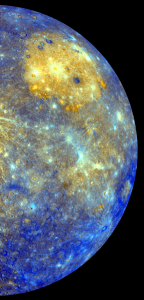MONDAY, 21 MARCH 2011
The MErcury Surface, Space ENvironment, Geochemistry, and Ranging probe made a flyby of Earth and two flybys of Venus to put it onto the correct trajectory to reach the closest planet to the Sun. Thrusters on the spacecraft slowed MESSENGER down by 1,292 mph to ease it into orbit 96 million miles from Earth [1].
MESSENGER will also measure the composition of Mercury’s thin exosphere, and its neutron spectrometer will search for hydrogen in the permanently shadowed interior of craters at the planet’s poles. Radar pictures from Earth show material in the craters that resemble ice, but whether these deposits contain water, sulfur or another material is one of Mercury’s great mysteries [3].
Written by Robert Jones

